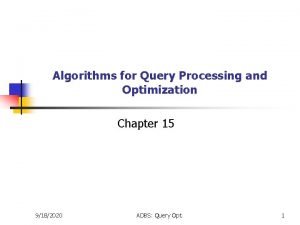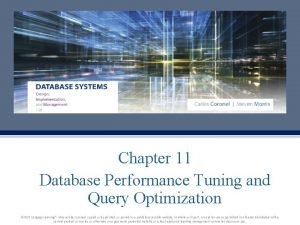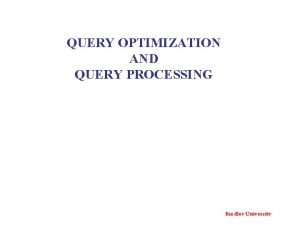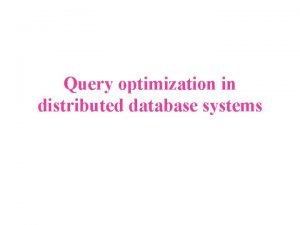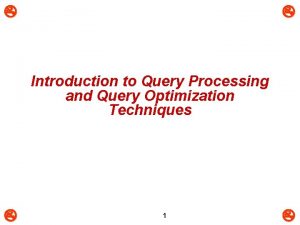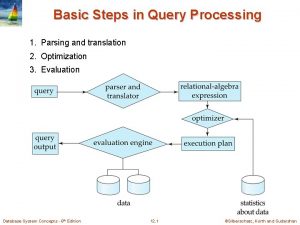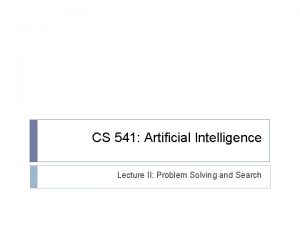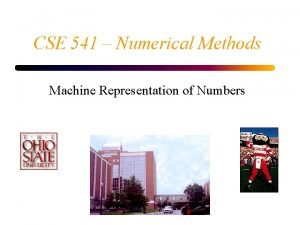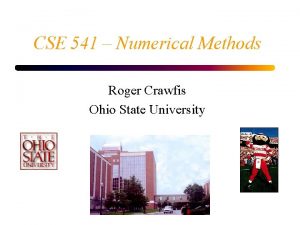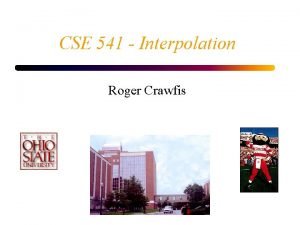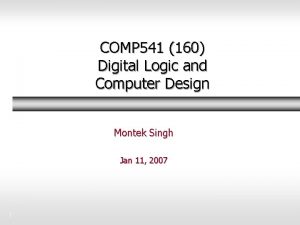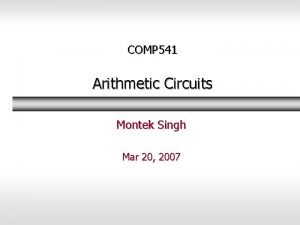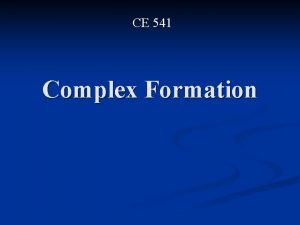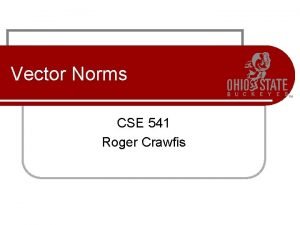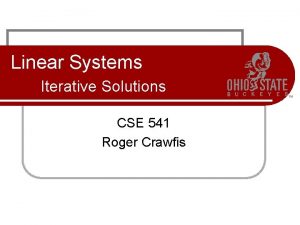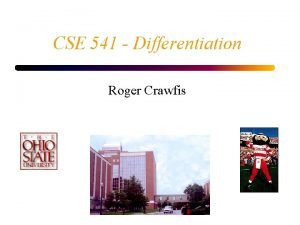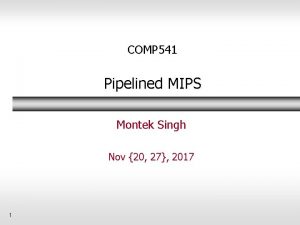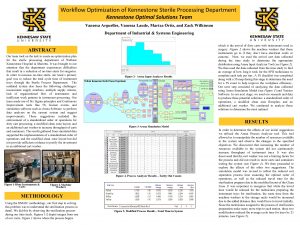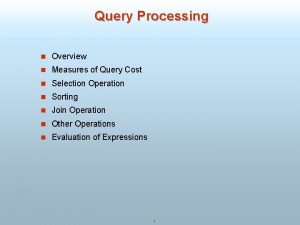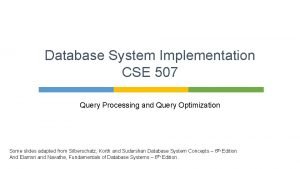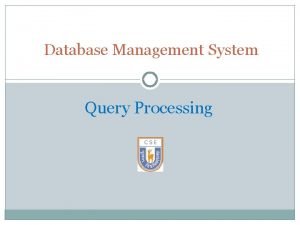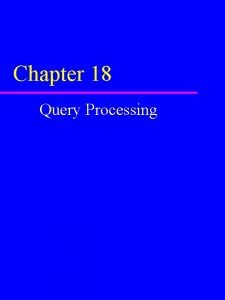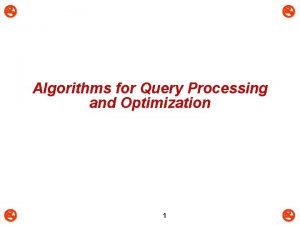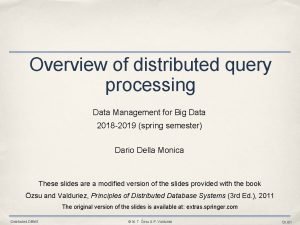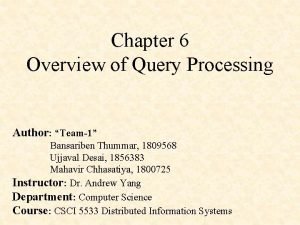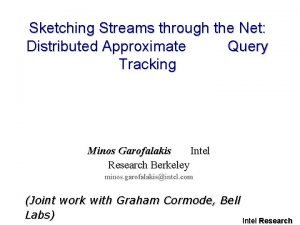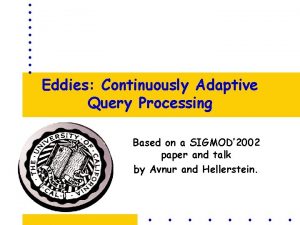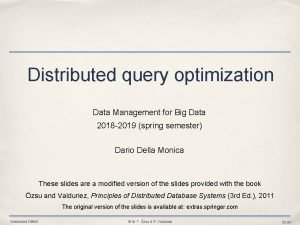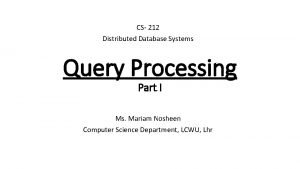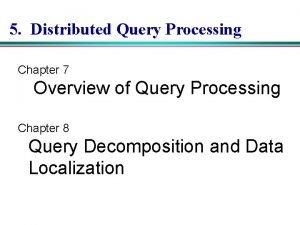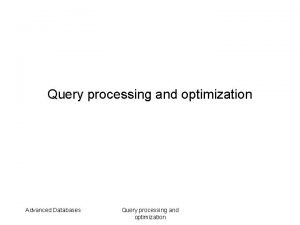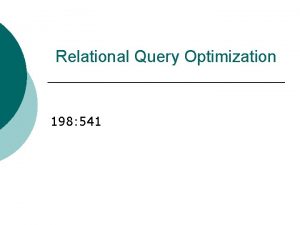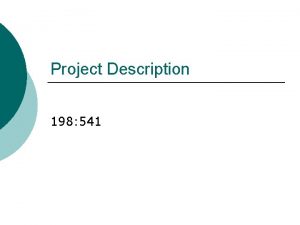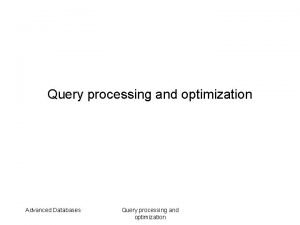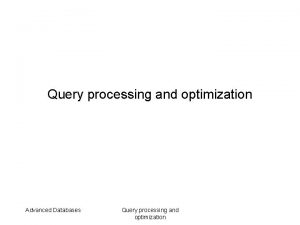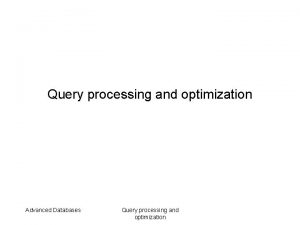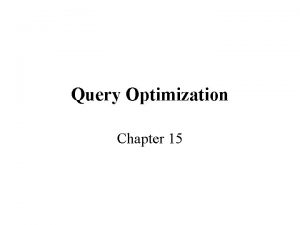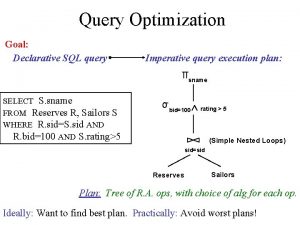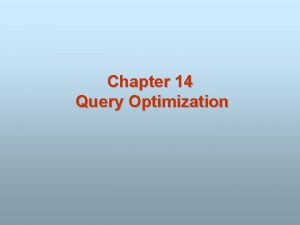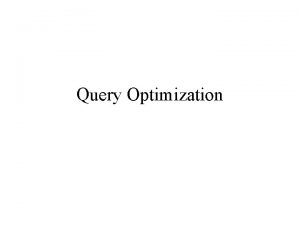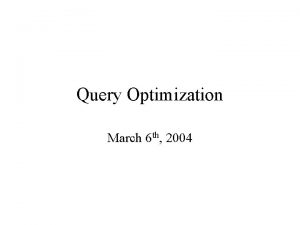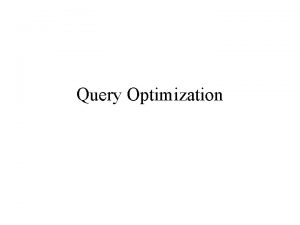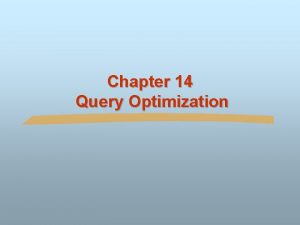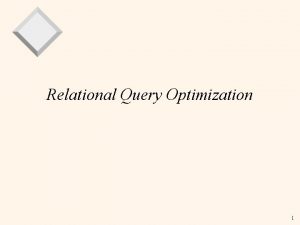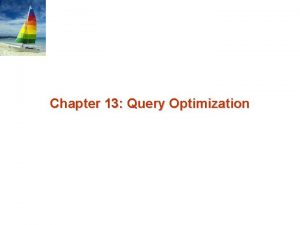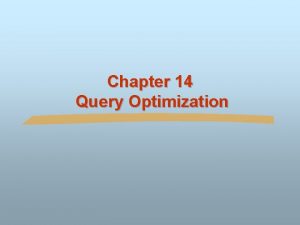Topk Query Processing and Optimization 198 541 slides












![Top-k Selection Filter/Restart Method [Carey and Kossman SIGMOD’ 97] [Donjerkovic and Ramakrishnan VLDB’ 99] Top-k Selection Filter/Restart Method [Carey and Kossman SIGMOD’ 97] [Donjerkovic and Ramakrishnan VLDB’ 99]](https://slidetodoc.com/presentation_image_h/1d1707d95b62d001fc7198017fbe0757/image-13.jpg)




![Top-k Selection Rank Aggregation from Multiple Lists TA [Fagin et al. PODS’ 01], Quick-combine Top-k Selection Rank Aggregation from Multiple Lists TA [Fagin et al. PODS’ 01], Quick-combine](https://slidetodoc.com/presentation_image_h/1d1707d95b62d001fc7198017fbe0757/image-18.jpg)

![Top-k Selection Rank Aggregation from Multiple Lists NRA [Fagin et al. PODS’ 01], Stream-combine Top-k Selection Rank Aggregation from Multiple Lists NRA [Fagin et al. PODS’ 01], Stream-combine](https://slidetodoc.com/presentation_image_h/1d1707d95b62d001fc7198017fbe0757/image-20.jpg)

![Top-k Selection Rank Aggregation from Multiple Lists Upper [Bruno et al. ICDE’ 02] MPro Top-k Selection Rank Aggregation from Multiple Lists Upper [Bruno et al. ICDE’ 02] MPro](https://slidetodoc.com/presentation_image_h/1d1707d95b62d001fc7198017fbe0757/image-22.jpg)
![Top-k Selection Materialized Views (PREFER) [Hristidis et al. SIGMOD’ 01] n Ranking function m Top-k Selection Materialized Views (PREFER) [Hristidis et al. SIGMOD’ 01] n Ranking function m](https://slidetodoc.com/presentation_image_h/1d1707d95b62d001fc7198017fbe0757/image-23.jpg)






![Ranking in Relational Databases Range queries [Bruno et al. TODS’ 02] n Filter/Restart Method Ranking in Relational Databases Range queries [Bruno et al. TODS’ 02] n Filter/Restart Method](https://slidetodoc.com/presentation_image_h/1d1707d95b62d001fc7198017fbe0757/image-30.jpg)





![References (1) n [ACE+03] Walid G. Aref, Ann C. Catlin, Ahmed K. Elmagarmid, J. References (1) n [ACE+03] Walid G. Aref, Ann C. Catlin, Ahmed K. Elmagarmid, J.](https://slidetodoc.com/presentation_image_h/1d1707d95b62d001fc7198017fbe0757/image-36.jpg)
![References (2) n [CH 02] Kevin Chen. Chuan Chang and Seung won Hwang. Minimal References (2) n [CH 02] Kevin Chen. Chuan Chang and Seung won Hwang. Minimal](https://slidetodoc.com/presentation_image_h/1d1707d95b62d001fc7198017fbe0757/image-37.jpg)
![References (3) n [GBK 01] Ulrich G˜untzer, Wolf. Tilo Balke, and Werner Kießling. Towards References (3) n [GBK 01] Ulrich G˜untzer, Wolf. Tilo Balke, and Werner Kießling. Towards](https://slidetodoc.com/presentation_image_h/1d1707d95b62d001fc7198017fbe0757/image-38.jpg)
![References (4) n [LCI+05] Chengkai Li, Kevin. C. -C. Chang, Ihab F. Ilyas, and References (4) n [LCI+05] Chengkai Li, Kevin. C. -C. Chang, Ihab F. Ilyas, and](https://slidetodoc.com/presentation_image_h/1d1707d95b62d001fc7198017fbe0757/image-39.jpg)
- Slides: 39

Top-k Query Processing and Optimization 198: 541 (slides courtesy of Ihab F. Ilyas and Walid G. Aref)

Outline Motivation with Examples n Query Model n Top-k Selection n Top-k Join n Ranking in Relational Query Engines n Summary n Open Research Topics n

Outline Motivation with Examples n Query Model n Top-k Selection n Top-k Join n Ranking in Relational Query Engines n Summary n Open Research Topics n

Motivation n n Information Retrieval/ Database systems integration IR: uncertainty and ranking for effective retrieval Database Systems: advanced data management Supporting new data types is certainly not enough True integration includes (among other things): n n n Indexing Query processing and optimization Query Language

Motivation n Applications n n n New requirements n n Multimedia search by contents (multi-features/examples) Middleware Search engines Data mining Multi-criteria ranking Rank aggregation from external sources Joining ranked infinite streams Most applications are interested in the top-k results

Query Example 1: Ranking in Multimedia Retrieval Color Histogram Edge Histogram Texture Video Database Color Histogram Edge Histogram Texture

Example 2 SELECT h. id , s. name FROM houses h , schools s WHERE h. location = s. location ORDER BY h. price+10 x s. tuition STOP AFTER 10 RANK( ) OVER in SQL 99

Example 2 (Cont’d) ID Location Price ID Location Tuition 1 3 150000 1 2 3 4 5 6 90, 000 111, 000 118, 000 125, 000 154, 000 1 2 3 4 5 6 7 8 3000 3500 6000 6200 7000 7900 8200 1 4 15200 2 2 014500 Lafayette W. Lafayette Indianapolis Kokomo Lafayette Kokomo …… Houses Indianapolis W. Lafayette Indianapolis Kokomo Schools 3 1 014100 0

Outline Motivation with Examples n Theoretical Foundation of Rank Aggregation n Query Model n Top-k Selection n Top-k Join n Ranking in Relational Query Engines n Summary n Open Research Topics n

Query Model: Top-k Selection n One relation R with: n attributes A 1, … , An n m scores s 1, …. , sm n Scores are expressions over the attributes n Example: s 1 = A 1 and s 2=A 2+A 3 n n n A combining function F to compute total score An example template: SELECT some_attributes FROM R WHERE selection_condition ORDER BY F(s 1, …, sm) STOP AFTER k

Query Model: Top-k Join n m Relations R 1, …. . , Rm | Ri has: n n n attributes score attribute, si (can be an expression over other attributes) A global score for a join result is computed as F(s 1, …. , sm) An example template: SELECT some_attributes FROM R 1, …. . , Rm WHERE join_condition ORDER BY F(s 1, …. . , sm) STOP AFTER k

Top-k Selection Queries n Approaches: Filter/Restart method n Rank aggregation from multiple lists n Using indexes and materialized views n
![Topk Selection FilterRestart Method Carey and Kossman SIGMOD 97 Donjerkovic and Ramakrishnan VLDB 99 Top-k Selection Filter/Restart Method [Carey and Kossman SIGMOD’ 97] [Donjerkovic and Ramakrishnan VLDB’ 99]](https://slidetodoc.com/presentation_image_h/1d1707d95b62d001fc7198017fbe0757/image-13.jpg)
Top-k Selection Filter/Restart Method [Carey and Kossman SIGMOD’ 97] [Donjerkovic and Ramakrishnan VLDB’ 99] [Bruno et al. TODS’ 02] [Chaudhuri et al. TKDE’ 04] n n n Map the top-k query to a selection predicate x > t For multi-criteria ranking (multiple scoring attributes) a range query t 11< x 1 <t 12 and t 21 < x 2 < t 22 Estimate the cut-off t based on k and the data distribution

Top-k Selection Rank Aggregation from Multiple Lists L 1. ID = L 2. ID ID S 1 S 2 ID S 2 15 12 3 24 45 50 40 20 40 30 10 20 50 10 30 40 50 20 10 3 2 1 4 5 50 40 30 20 10

Top-k Selection Rank Aggregation from Multiple Lists n Assumptions: n n n Differ in the access capabilities on the lists n n Sorted Access Only Sorted + Random Access Only ! Differ in pipeline support n n Sorted Inputs on the individual scores The combining function is monotone The output can serve as input to another instance Most Algorithms can be cast as a specialization of the A* algorithm

Top-k Selection Rank Aggregation from Multiple Lists FA, TA, Quick-combine, Multi-Step Sorted Access Only Random Access/ BOTH Probes NRA, Stream-combine Only MPro, Upper, Pick

Top-k Selection Rank Aggregation from Multiple Lists n Sorted + Random Access Available n n n Go in the lists in parallel Keep track of all “seen” objects Update scores of objects at each step Maintain a threshold T: an upper-bound for all the unknown scores An object is qualified as a top-k if n The object’s combined score is known and is greater than T
![Topk Selection Rank Aggregation from Multiple Lists TA Fagin et al PODS 01 Quickcombine Top-k Selection Rank Aggregation from Multiple Lists TA [Fagin et al. PODS’ 01], Quick-combine](https://slidetodoc.com/presentation_image_h/1d1707d95b62d001fc7198017fbe0757/image-18.jpg)
Top-k Selection Rank Aggregation from Multiple Lists TA [Fagin et al. PODS’ 01], Quick-combine [Güntzer et al. VLDB’ 00], Multi-step [Nepal and Ramakrishna ICDE’ 99] Algorithm Sketch: F= S 1 + S 2 ID S 1 ID S 2 5 1 3 2 4 50 40 30 20 10 3 2 1 4 5 50 40 30 20 10 Random Access T == 80 100 T 3: 3: (80) 1: 5: (70) (60) 5: (60) 2: (60) Buffer

Top-k Selection Rank Aggregation from Multiple Lists n No Random Access available n The combined score of an object is two parts: n n “Seen”: From lists where we encountered the object “Unseen”: Upper bound of all missing scores Sounds familiar? A* search An object is qualified as a top-k if n The object’s lower-bound score is greater than the upperbound score of all other objects
![Topk Selection Rank Aggregation from Multiple Lists NRA Fagin et al PODS 01 Streamcombine Top-k Selection Rank Aggregation from Multiple Lists NRA [Fagin et al. PODS’ 01], Stream-combine](https://slidetodoc.com/presentation_image_h/1d1707d95b62d001fc7198017fbe0757/image-20.jpg)
Top-k Selection Rank Aggregation from Multiple Lists NRA [Fagin et al. PODS’ 01], Stream-combine [Güntzer et al. ITCC’ 00] F= S 1 + S 2 Algorithm Sketch: ID S 1 ID S 2 5 1 3 2 4 50 40 30 20 10 3 2 1 4 5 50 40 30 20 10 5: 3: (50 (80 – 100) 90) 80) 3: 1: (50 (70 – 100) 90) 70) 1: (50 5: (40 – 80) 2: (40 – 70) 80) Buffer

Top-k Selection Rank Aggregation from Multiple Lists n At least one attribute with sorted-access n Some with no Sorted Access (Probe Attributes) n Schedule the Probe Attributes using statistics in ascending order of their “probing” cost
![Topk Selection Rank Aggregation from Multiple Lists Upper Bruno et al ICDE 02 MPro Top-k Selection Rank Aggregation from Multiple Lists Upper [Bruno et al. ICDE’ 02] MPro](https://slidetodoc.com/presentation_image_h/1d1707d95b62d001fc7198017fbe0757/image-22.jpg)
Top-k Selection Rank Aggregation from Multiple Lists Upper [Bruno et al. ICDE’ 02] MPro [Chang and Hwang SIGMOD’ 02], Algorithm Sketch: ID a b c d e s 0. 90 0. 80 0. 70 0. 60 0. 50 p 1. 85. 78. 75. 90. 70 p 2 Min(s, p 1, p 2). 75. 90. 78. 20. 90. 60. 80. 50 Upper-bound of the unseen scores Uunseen= 0. 9 0. 8 0. 7 a: 0. 85 a: 0. 9 b: 0. 8 b: 0. 78 b: 0. 8 a: 0. 75 c: 0. 7 Candidates Queue
![Topk Selection Materialized Views PREFER Hristidis et al SIGMOD 01 n Ranking function m Top-k Selection Materialized Views (PREFER) [Hristidis et al. SIGMOD’ 01] n Ranking function m](https://slidetodoc.com/presentation_image_h/1d1707d95b62d001fc7198017fbe0757/image-23.jpg)
Top-k Selection Materialized Views (PREFER) [Hristidis et al. SIGMOD’ 01] n Ranking function m f v = å vi. Score i i =1 n Materialize a view that ranks the entire input relation on fv | v =(v 1, v 2, . . . , vm) (predefined weights) n For an input query weights q =(q 1, q 2, …, qm) n n n Get a prefix of the view based on v and q Sort the prefix on fq The top results are guaranteed to be in the prefix

Top-k Selection Materialized Views (PREFER) n The prefix: n ID 1 2 3 4 5 6 Determine a threshold Tv, q| "t Î R, f v (t ) < Tv , q Þ f q (t ) < f q (tv 1 ) A 1 10 20 17 15 5 15 A 2 17 20 18 10 10 10 A 3 20 11 12 8 12 5 fv(t) 16. 8 16. 4 15. 4 10. 2 9. 8 9 fq(t) 17. 2 17. 3 16. 1 9. 9 10. 1 9 v =(0. 2, 0. 4) q =(0. 1, 0. 6, 0. 3) Maximize fv(t) while maintaining inequality Tv, q = 14. 26

Top-k Selection Materialized Views (PREFER) n Multiple views n n For each query q, a view v that covers q with some prefix constraint 10 to 100 views is a typical number to cover the space of queries Heuristic to cover the maximum number of queries using n views View selection for an input query n n n Store view coverage in an R-tree A query is a point in the space Get the view that contains the query

Outline Motivation with Examples n Theoretical Foundation of Rank Aggregation n Query Model n Top-k Selection n Top-k Join n Ranking in Relational Query Engines n Summary n Open Research Topics n

Top-k Join n m Relations R 1, …. . , Rm | Ri has: n n n attributes score attribute, si (can be an expression over other attributes) A global score for a join result is computed as F(s 1, …. , sm) An example template: SELECT some_attributes FROM R 1, …. . , Rm WHERE join_condition ORDER BY F(s 1, …. . , sm) STOP AFTER k

Outline Motivation with Examples n Theoretical Foundation of Rank Aggregation n Query Model n Top-k Selection n Top-k Join n Ranking in Relational Query Engines n Summary n Open Research Topics n

Supporting Ranking in Relational Databases Approaches: n Map to a multi-dimensional range query (Filter/Restart) n User defined function n Core implementation as a query operator n New Algebra n The notion of ranked relations n Algorithms implement the ranking process
![Ranking in Relational Databases Range queries Bruno et al TODS 02 n FilterRestart Method Ranking in Relational Databases Range queries [Bruno et al. TODS’ 02] n Filter/Restart Method](https://slidetodoc.com/presentation_image_h/1d1707d95b62d001fc7198017fbe0757/image-30.jpg)
Ranking in Relational Databases Range queries [Bruno et al. TODS’ 02] n Filter/Restart Method Given a top-k selection query q over a relation R n Use multidimensional histogram H to estimate a search distance dq n The region (q, dq) contains is expected to include the top-k answers n Perform a range query on (q, dq) n Return top-k answers of the results n If #results < k, RESTART n

Ranking in Relational Databases Range queries n Using histograms n n Create a small synthetic Relation S consistent with the histogram on R Compute the Dist(q, t) for every tuple t in S dq is the maximum distance between q and the top-k tuples in S Building S n n No restarts: dq is large enough more results need to be filtered Restarts: restarts possible less filtering

Supporting Ranking in Relational Databases As a Query Operator User-defined Function (+) Under the optimizer's control (+)Can be shuffled with other operators in a query evaluation plan for better performance (+)General enough and highly applicable (-)Changes to query engine (+)Easy to implement and ready-to-go solution (-)Implementation outside the SQL engine lose efforts of the query optimizer

Outline Motivation with Examples n Theoretical Foundation of Rank Aggregation n Query Model n Top-k Selection n Top-k Join n Ranking in Relational Query Engines n Summary n Open Research Topics n

Summary n Wide applicability of ranking queries as essential functionality in many applications warrants efficient handling by database systems n One step towards integrating IR effective retrieval and DB effective handling of data n Defined two flavors: n n n Top-k Selection Queries Top-k Join Queries Basic Techniques: n n n Filter / Restart Rank Aggregation Using Indexes and Materialized Views

Summary n Rank Aggregation has solid theoretical background from voting and social selection n Many rank-aggregation algorithms available with similar core idea n Challenges n n Unified framework for rank-aware query processing Integrating rank-aggregation as a basic operation in practical relational database systems
![References 1 n ACE03 Walid G Aref Ann C Catlin Ahmed K Elmagarmid J References (1) n [ACE+03] Walid G. Aref, Ann C. Catlin, Ahmed K. Elmagarmid, J.](https://slidetodoc.com/presentation_image_h/1d1707d95b62d001fc7198017fbe0757/image-36.jpg)
References (1) n [ACE+03] Walid G. Aref, Ann C. Catlin, Ahmed K. Elmagarmid, J. Fan, Moustafa A. Hammad, Ihab F. Ilyas, Mirette Marzouk, Sunil Prabhakar, and X. Zhu. VDBMS: A testbed facility for research in video database bench marking. ACM Multimedia Systems Journal, Special Issue on Multimedia Document Management Systems, 2003. n [ASC 02] Sihem Amer-Yahia, Sung. Ran Cho, Divesh Srivastava, Tree Pattern Relaxation, In EDBT, 2002 n [BCG 02] Nicolas Bruno, Surajit Chaudhuri, and Luis Gravano. Top-k selection queries over relational databases: Mapping strategies and performance evaluation. TODS, 27(2), 2002. n [BGM 02] Nicolas Bruno, Luis Gravano, Amélie Marian: Evaluating Top-k Queries over Web. Accessible Databases. In ICDE, 2002 n [CBC+00] Yuan. Chi Chang, Lawrence Bergman, Vittorio Castelli, Chung. Sheng Li, Ming. Ling Lo, and John R. Smith. The onion technique: indexing for linear optimization queries. In SIGMOD, 2000. n [CK 97] Michael J. Carey and Donald Kossmann, On saying ``Enough already !” in SQL, SIGMOD, 1997 Tucson, Arizona
![References 2 n CH 02 Kevin Chen Chuan Chang and Seung won Hwang Minimal References (2) n [CH 02] Kevin Chen. Chuan Chang and Seung won Hwang. Minimal](https://slidetodoc.com/presentation_image_h/1d1707d95b62d001fc7198017fbe0757/image-37.jpg)
References (2) n [CH 02] Kevin Chen. Chuan Chang and Seung won Hwang. Minimal probing: supporting expensive predicates for top-k queries. In SIGMOD, 2002. n [Con 85] M. J. Condorcet. Essai sur l'application de l'analyse a la probabilit e des decisions rendues a la puralite des voix, 1785. n [DKN+01] Cynthia Dwork, S. Ravi Kumar, Moni Naor, and D. Sivakumar. Rank aggregation methods for the web. In World Wide Web, 2001. n [DR 99] Donko Donjerkovic, Raghu Ramakrishnan: Probabilistic Optimization of Top N Queries. In VLDB 1999 n [Fag 99] Ronald Fagin. Combining fuzzy information from multiple systems. Journal of Computer and System Sciences (JCSS), 58(1), Feb 1999. n [FLN 01] Ronald Fagin, Amnon Lotem, and Moni Naor. Optimal aggregation algorithms for middleware. In PODS, Santa Barbara, California, May 2001. n [GBK 00] Ulrich G˜untzer, Wolf. Tilo Balke, and Werner Kießling. Optimizing multifeature queries for image databases. In VLDB, September 10 --14, Cairo, Egypt, 2000.
![References 3 n GBK 01 Ulrich Guntzer Wolf Tilo Balke and Werner Kießling Towards References (3) n [GBK 01] Ulrich G˜untzer, Wolf. Tilo Balke, and Werner Kießling. Towards](https://slidetodoc.com/presentation_image_h/1d1707d95b62d001fc7198017fbe0757/image-38.jpg)
References (3) n [GBK 01] Ulrich G˜untzer, Wolf. Tilo Balke, and Werner Kießling. Towards efficient multifeature queries in heterogeneous environments. In ITCC, 2001. n [HGP 03] Vagelis Hristidis, Luis Gravano, and Yannis Papakonstantinou. Efficient IR-style keyword search over relational databases. In VLDB, Berlin, Germany, 2003. n [HKP 01] Vagelis Hristidis, Nick Koudas, and Yannis Papakonstantinou. PREFER: A system for the efficient execution of multiparametric ranked queries. In SIGMOD, Santa Barbara, California, 2001 n [IAE 02] Ihab F. Ilyas, Walid G. Aref, and Ahmed K. Elmagarmid. Joining Ranked Inputs in Practice. In VLDB, Honk-Kong, China, 2002. n [IAE 03] Ihab F. Ilyas, Walid G. Aref, and Ahmed K. Elmagarmid. Supporting top-k join queries in relational databases. In VLDB, Berlin, Germany, 2003. n [ISA+04] Ihab F. Ilyas, Rahul Shah, Walid G. Aref, Jeff Vitter, and Ahmed K. Elmagarmid. Rank-aware Query Optimization. SIGMOD, Paris, France, 2004
![References 4 n LCI05 Chengkai Li Kevin C C Chang Ihab F Ilyas and References (4) n [LCI+05] Chengkai Li, Kevin. C. -C. Chang, Ihab F. Ilyas, and](https://slidetodoc.com/presentation_image_h/1d1707d95b62d001fc7198017fbe0757/image-39.jpg)
References (4) n [LCI+05] Chengkai Li, Kevin. C. -C. Chang, Ihab F. Ilyas, and Sumin Song Rank. SQL: Query n [NCS+01] Apostol Natsev, Yuan. Chi Chang, John R. Smith, Chung. Sheng Li, and Jeffrey Scott Vitter. Supporting incremental join queries on ranked inputs. In VLDB, Rome, Italy, 2001. n [NR 99] Surya Nepal and M. V. Ramakrishna. Query processing issues in image (multimedia) databases. In ICDE, Sydney, Australia, 1999. n [RGM 03] Sriram Raghavan and Hector Garcia. Molina. Complex queries over web repositories. In VLDB, Berlin, Germany, 2003. n [TPK+03] Panayiotis Tsaparas, Themistoklis Palpanas, Yannis Kotidis, Nick Koudas, and Divesh Srivastava. Ranked join indices, ICDE 2003. n [UF 01] Tolga Urhan and Michael J. Franklin. Dynamic pipeline scheduling for improving interactive query performance. In VLDB, Roma, Italy, 2001. Algebra and Optimization for Relational Top-k Queries. In Proceedings of the 2005 ACM SIGMOD Conference on Management of Data, Baltimore, Maryland (To Appear)
 Algorithms for query processing and optimization
Algorithms for query processing and optimization Database performance tuning and query optimization
Database performance tuning and query optimization Query tree and query graph
Query tree and query graph Query tree and query graph
Query tree and query graph Cosmos db query optimization
Cosmos db query optimization Query optimization in distributed database
Query optimization in distributed database Steps in query processing
Steps in query processing Dns recursive iterative
Dns recursive iterative Steps of query processing
Steps of query processing Cs 541 stevens
Cs 541 stevens Cse 541
Cse 541 Comp 541
Comp 541 Roger crawfis osu
Roger crawfis osu Cse 541
Cse 541 Unc comp 541
Unc comp 541 Comp 541
Comp 541 Comp 541
Comp 541 541 ce
541 ce 29 cfr part 541
29 cfr part 541 Norm of a vector
Norm of a vector S-o-r
S-o-r Cse 541
Cse 541 Comp 541
Comp 541 A small child slides down the four frictionless slides
A small child slides down the four frictionless slides John pushes hector on a plastic toboggan
John pushes hector on a plastic toboggan Sterile workflow optimization
Sterile workflow optimization Steps in query processing
Steps in query processing Steps in query processing
Steps in query processing Measures of query cost in dbms
Measures of query cost in dbms Objectives of query processing
Objectives of query processing Steps in query processing
Steps in query processing Distributed query processing
Distributed query processing Characterization of query processors
Characterization of query processors Sketch techniques for approximate query processing
Sketch techniques for approximate query processing What is the role of eddy in adaptive query processing
What is the role of eddy in adaptive query processing Distributed query processing
Distributed query processing Distributed query processing
Distributed query processing Distributed query processing
Distributed query processing Which algorithm
Which algorithm Sql server intelligent query processing
Sql server intelligent query processing
